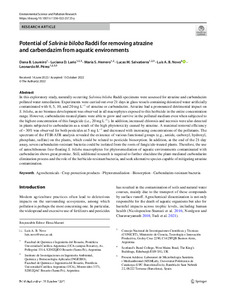Por favor, use este identificador para citar o enlazar este ítem:
https://repositorio.uca.edu.ar/handle/123456789/15391| Título : | Potential of salvinia biloba raddi for removing atrazine and carbendazim from aquatic environments | Autor : | Loureiro, Dana B. Lario, Luciana Daniela Herrero, María Sol Salvatierra, Lucas Matías Novo, Luís A. B. Pérez, Leonardo Martín |
Palabras clave : | AGROQUIMICOS; FITORREMEDIACION; CONTAMINACION DEL AGUA; PRODUCTOS FITOSANITARIOS; BACTERIAS RESISTENTES A CARBENDAZIMA; BIOSORCIÓN; SALVINIA BILOBA RADDI; TRATAMIENTO DE AGUAS RESIDUALES | Fecha de publicación : | 2022 | Editorial : | Springer | Cita : | Loureiro, D. B. et al. Potential of salvinia biloba raddi for removing atrazine and carbendazim from aquatic environments [en línea]. Environmental science and pollution research international. 2022. doi:10.1007/s11356-022-23725-y. Disponible en: https://repositorio.uca.edu.ar/handle/123456789/15391 | Resumen : | Abstract: In this exploratory study, naturally occurring Salvinia biloba Raddi specimens were assessed for atrazine and carbendazim polluted water remediation. Experiments were carried out over 21 days in glass vessels containing deionized water artifcially contaminated with 0, 5, 10, and 20 mg L−1 of atrazine or carbendazim. Atrazine had a pronounced detrimental impact on S. biloba, as no biomass development was observed in all macrophytes exposed to this herbicide in the entire concentration range. However, carbendazim-treated plants were able to grow and survive in the polluted medium even when subjected to the highest concentration of this fungicide (i.e., 20 mg L−1). In addition, increased chlorosis and necrosis were also detected in plants subjected to carbendazim as a result of the high phytotoxicity caused by atrazine. A maximal removal efciency of~30% was observed for both pesticides at 5 mg L−1 and decreased with increasing concentrations of the pollutants. The spectrum of the FTIR-ATR analysis revealed the existence of various functional groups (e.g., amide, carboxyl, hydroxyl, phosphate, sulfate) on the plants, which could be related to pesticide biosorption. In addition, at the end of the 21-day assay, seven carbendazim-resistant bacteria could be isolated from the roots of fungicide-treated plants. Therefore, the use of autochthonous free-foating S. biloba macrophytes for phytoremediation of aquatic environments contaminated with carbendazim shows great promise. Still, additional research is required to further elucidate the plant-mediated carbendazim elimination process and the role of the herbicide-resistant bacteria, and seek alternative species capable of mitigating atrazine contamination. | URI : | https://repositorio.uca.edu.ar/handle/123456789/15391 | ISSN : | 0944-1344 1614-7499 (online) |
Disciplina: | QUIMICA | DOI: | 10.1007/s11356-022-23725-y | Derechos: | Acceso abierto |
| Aparece en las colecciones: | Artículos |
Ficheros en este ítem:
| Fichero | Descripción | Tamaño | Formato | |
|---|---|---|---|---|
| potential-salvinia-biloba-raddi.pdf | 2,05 MB | Adobe PDF |  Visualizar/Abrir |
Visualizaciones de página(s)
65
comprobado en 27-abr-2024
Descarga(s)
46
comprobado en 27-abr-2024
Google ScholarTM
Consultar
Altmetric
Este ítem está sujeto a una licencia Creative Commons Licencia Creative Commons

